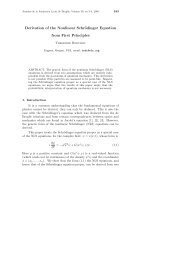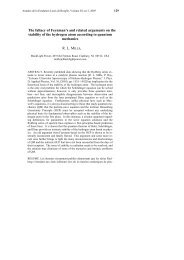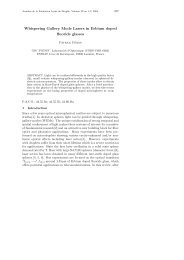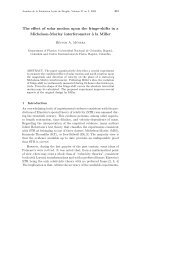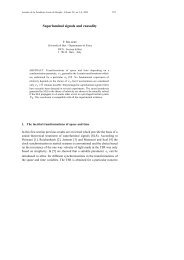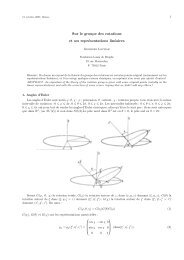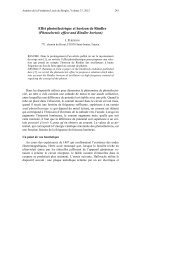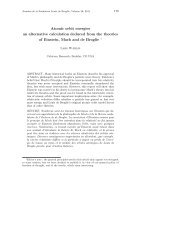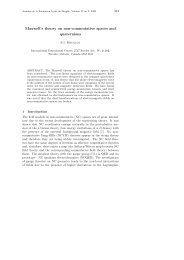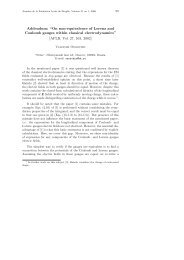Geometrical Properties and Propagation for the Proca Field Theory
Geometrical Properties and Propagation for the Proca Field Theory
Geometrical Properties and Propagation for the Proca Field Theory
Create successful ePaper yourself
Turn your PDF publications into a flip-book with our unique Google optimized e-Paper software.
<strong>Properties</strong> <strong>and</strong> <strong>Propagation</strong> of <strong>Proca</strong> <strong>the</strong> <strong>Field</strong> 21<strong>and</strong> differential operations D µ are defined through <strong>the</strong> connections Γ ρ αβ ;<strong>the</strong> metric tensor are to be such that <strong>the</strong>y can be locally reduced to <strong>the</strong>Minkowskian <strong>for</strong>m, <strong>and</strong> <strong>the</strong> covariant derivatives applied upon <strong>the</strong> metrictensors are required to vanish according to what is called metricity conditionD µ g = 0, as it has been discussed in reference [3]. Then, requiringthis condition of metricity <strong>for</strong> any connection leads to <strong>the</strong> complete antisymmetryof Cartan torsion tensor Q αµρ , as explained in reference [4].Fur<strong>the</strong>r, we will define Riemann tensor with G αβµν antisymmetric inboth <strong>the</strong> first <strong>and</strong> <strong>the</strong> second couple of indices, with one independentcontraction given by <strong>the</strong> Ricci tensor G λ αλβ = G αβ, whose contraction isgiven by <strong>the</strong> Ricci scalar G αβ g αβ = G <strong>and</strong> this will set our conventionup.Riemann curvature tensor, Ricci curvature tensor <strong>and</strong> scalar, toge<strong>the</strong>rwith Cartan torsion tensor verify <strong>the</strong> identities(D ρ Q ρµν + G νµ − 1 ) (2 gνµ G − G µν − 1 )2 gµν G ≡ 0 (1)<strong>and</strong>D µ(G µρ − 1 )2 gµρ G(− G µβ − 1 )2 g µβG Q βµρ + 1 2 Gµκβρ Q βµκ ≡ 0(2)which are geometric identities, called Jacobi-Bianchi identities.We remark that from <strong>the</strong> metric tensor it is possible to define <strong>the</strong>Levi-Civita tensor ε βµρσ <strong>for</strong> which D µ ε βµρσ = 0 identically; in turn,since torsion is completely antisymmetric <strong>the</strong>n we can writeQ βµρ = ε βµρσ W σ (3)in terms of what is known to be <strong>the</strong> axial torsion vector, useful in <strong>the</strong>following.Within this background, to define matter fields that can be classifiedaccording to <strong>the</strong> value of <strong>the</strong>ir spin we have to consider that a givenmatter field of spin s possesses 2s + 1 degrees of freedom, which have tocorrespond to <strong>the</strong> 2s + 1 independent solutions of a system of equationsthat specify <strong>the</strong> highest-order time derivative <strong>for</strong> all components of <strong>the</strong>field, called system of matter field equations; however, since it may happenthat field equations are not enough to determine <strong>the</strong> correct rankof <strong>the</strong> solution, restrictions need to be imposed in terms of equations
<strong>Properties</strong> <strong>and</strong> <strong>Propagation</strong> of <strong>Proca</strong> <strong>the</strong> <strong>Field</strong> 23to be such that <strong>the</strong> relationships<strong>and</strong>D ρ S ρµν + 1 2 (T µν − T νµ ) = 0 (4)D µ T µρ − T µβ Q βµρ − S βµκ G µκβρ = 0 (5)are verified, implying <strong>the</strong> whole set of field equations<strong>and</strong>G σρ − 1 2 gσρ G = − 1 2 T σρ (6)Q νσρ = S νσρ (7)to be such that <strong>the</strong> conservation laws (1) <strong>and</strong> (2) are satisfied automatically.This determines <strong>the</strong> setting of <strong>the</strong> fundamental field equations inminimal coupling, that is taking <strong>the</strong> least-order derivative in <strong>the</strong> fieldequations.3 <strong>Propagation</strong> <strong>and</strong> <strong>Geometrical</strong> <strong>Properties</strong>Having settled this background, <strong>and</strong> because <strong>the</strong> background has restrictions<strong>the</strong>n matter fields will be restricted correspondingly, as alsoexplained in [6].To consider which matter vector fields could possibly be definedwithin this background, we see that in <strong>the</strong> case of a vector V µ it is possibleto define beside <strong>the</strong> st<strong>and</strong>ard covariant derivative given in terms of<strong>the</strong> connection ano<strong>the</strong>r most special differential operation written in <strong>the</strong><strong>for</strong>m Z µν = ∂ µ V ν −∂ ν V µ in terms of no additional field <strong>and</strong> called exteriorderivative or curl; this curl can be generalized up to <strong>the</strong> differential operatorgiven by Z ρµ = D ρ V µ −D µ V ρ that is <strong>for</strong>mally <strong>the</strong> curl but writtenwith respect to <strong>the</strong> most general connection with torsion: according tothis most general dynamical term, <strong>the</strong> most general <strong>Proca</strong> Lagrangianwill have kinetic terms given not only by <strong>the</strong> st<strong>and</strong>ard Z µα Z µα termbut also by <strong>the</strong> additional Z ηρ Z µα ε µαηρ term whose contributions arerelevant because in presence of torsion it cannot be written as a totaldivergence in <strong>the</strong> Lagrangian <strong>and</strong> <strong>the</strong>re<strong>for</strong>e neglected. The most general
24 L. Fabbriaction will <strong>the</strong>n be defined in terms of two parameters given by a parameterλ accounting <strong>for</strong> <strong>the</strong> additional terms of this generalization <strong>and</strong><strong>the</strong> mass m of <strong>the</strong> matter field.By varying this action with respect to <strong>the</strong> field involved we get <strong>the</strong><strong>Proca</strong> matter field equationsD µ Z µα + λ 2 D µZ ηρ ε µηρα + m 2 V α = 0 (8)which specify <strong>the</strong> second-order time derivative <strong>for</strong> only <strong>the</strong> spatial components,but which also develop <strong>the</strong> constraintm 2 D µ V µ − λ 4 Q ρµνD ρ Z αβ ε αβµν − 1 2 Qραβ D ρ Z αβ −− λ 2 D µQ ρ βν Z ραε αβµν − 1 2 D ρQ ραβ Z αβ = 0 (9)in which <strong>the</strong> terms with <strong>the</strong> second-order time derivative of spatial componentscan be removed by means of field equations showing that thisis a real constraint, which can <strong>the</strong>n be plugged back into <strong>the</strong> field equationsallowing <strong>the</strong>m to specify <strong>the</strong> second-order time derivative of allcomponents showing that <strong>the</strong>se are true field equations; <strong>the</strong> conservedquantities are given by <strong>the</strong> energy<strong>and</strong> <strong>the</strong> spinS ραβ = 1 2T αµ = − 1 2 gαµ m 2 V 2 + ( 14 gαµ Z ρη Z ρη − Z µθ Z α θ)++D ρ V µ ( Z ρα + λ 2 Z σθε σθρα) (10)[V α (Z ρβ + λ 2 Z σθε σθρβ )− V β (Z ρα + λ 2 Z σθε σθρα )](11)so that, whereas <strong>the</strong> conditionV α (Z ρβ + λ 2 Z σθε σθρβ )+ V ρ (Z αβ + λ 2 Z σθε σθαβ )= 0 (12)ensures <strong>the</strong> complete antisymmetry of <strong>the</strong> spin: this <strong>for</strong>m of <strong>the</strong> spin with<strong>the</strong> energy is such that one <strong>the</strong> field equations are considered <strong>the</strong>n <strong>the</strong>conservation laws (10) <strong>and</strong> (11) are satisfied <strong>and</strong> thus <strong>the</strong> Jacobi-Bianchiidentities verified.We notice that <strong>the</strong> field equations <strong>for</strong> <strong>the</strong> spin express <strong>the</strong> spin interms of <strong>the</strong> covariant derivatives of <strong>the</strong> field written in terms of <strong>the</strong>
<strong>Properties</strong> <strong>and</strong> <strong>Propagation</strong> of <strong>Proca</strong> <strong>the</strong> <strong>Field</strong> 25spin itself, <strong>and</strong> <strong>the</strong>re<strong>for</strong>e <strong>the</strong> field equations <strong>for</strong> <strong>the</strong> spin actually express<strong>the</strong> spin as an implicit relationship that can eventually be made explicitgiving as result <strong>the</strong> inverted relationship( ) 1 + λS ραβ 2= (∂ σ V ν − ∂ ν V σ ) V σ ε νραβ (13)3λin which <strong>the</strong> complete antisymmetry of <strong>the</strong> spin is manifest, <strong>and</strong> hencetorsion is writeable in terms of <strong>the</strong> torsionless derivatives of <strong>the</strong> field;<strong>the</strong>n it can be plugged back into <strong>the</strong> field equations to account <strong>for</strong> <strong>the</strong>back-reaction of torsion onto <strong>the</strong> field, or equivalently <strong>the</strong> autointeractionof <strong>the</strong> field with itself.Fur<strong>the</strong>r we can consider <strong>the</strong> condition of completely antisymmetricspin in its only independent contraction, of which we can take <strong>the</strong> divergence,thus obtaining two expressions from which it is possible to derive<strong>the</strong> conditionsV α V α = 0, Z ρβ Z ρβ + λ 2 Z ρβZ σθ ε σθρβ = 0 (14)<strong>and</strong> alsoor equivalentlyV ρ S ραβ = 0, Z ρβ S ρβα = 0 (15)V ρ W β − V β W ρ = 0, Z ρβ W α + Z βα W ρ + Z αρ W β = 0 (16)which are orthogonality conditions of <strong>the</strong> field <strong>and</strong> its exterior derivativeswith <strong>the</strong> torsion tensor; <strong>the</strong>se orthogonality conditions will considerablysimplify <strong>the</strong> expression of <strong>the</strong> field equations we are going to work out.Now, to study <strong>the</strong> propagation, it is possible to see that we have <strong>the</strong>number of degrees of freedom still correct; <strong>the</strong>n, <strong>the</strong> calculation of <strong>the</strong>characteristic equation gives3m 2 n 2 − ( 1 + λ 2) Z ρα Z ρβ n α n β = 0 (17)from which we have that causal propagation is always possible, but byintroducing Z 0i = E i <strong>and</strong> Z ij = −ε ijk B k <strong>the</strong>n whenever(n 0 ) 2 | ⃗ E| 2 − 2n 0 (⃗n · ⃗E × ⃗ B) − (|⃗n · ⃗E| 2 − |⃗n × ⃗ B| 2 ) < 0 (18)
26 L. Fabbriwe have that acausal propagation may occur <strong>and</strong> whenever|⃗n · ⃗E| 2 | ⃗ E| 2 + 2(⃗n · ⃗E)(⃗n · ⃗B)( ⃗ E · ⃗B) −−|⃗n · ⃗E| 2 | ⃗ B| 2 − |⃗n| 2 | ⃗ E · ⃗B| 2 < 0 (19)<strong>the</strong>re is no propagation whatsoever <strong>for</strong> <strong>the</strong> present <strong>Proca</strong> massive vectorfield.On <strong>the</strong> o<strong>the</strong>r h<strong>and</strong>, to study <strong>the</strong> geometrical properties, we noticethat torsion imposes through <strong>the</strong> condition of complete antisymmetryV α (Z ρβ + λ 2 Z σθε σθρβ )+ V ρ (Z αβ + λ 2 Z σθε σθαβ )= 0 (20)an additional constraint that does reduce to 2 <strong>the</strong> highest number ofdegrees of freedom, leaving this generalization of <strong>the</strong> <strong>Proca</strong> massive vectorfield with <strong>the</strong> same degrees of freedom of a massless vector field <strong>and</strong><strong>the</strong>re<strong>for</strong>e overdetermined.There<strong>for</strong>e, although not in terms of <strong>the</strong> propagator but ra<strong>the</strong>r interms of <strong>the</strong> torsional restrictions, this present generalization of <strong>the</strong><strong>Proca</strong> massive vector field is not defined correctly, <strong>and</strong> <strong>the</strong> most general<strong>Proca</strong> matter field is to be considered that in its original <strong>for</strong>m.4 ConclusionIn this paper, we have considered <strong>the</strong> <strong>Proca</strong> vector field in which <strong>the</strong> dynamicalterm is written in terms of <strong>the</strong> exterior derivative or equivalently<strong>the</strong> curl, calculated with respect to <strong>the</strong> most general metric connectionwith completely antisymmetric Cartan torsion tensor; also, ano<strong>the</strong>r dynamicalterms has been included in <strong>the</strong> field equations: this more generalfield equations have been discussed from <strong>the</strong> perspective of propagation<strong>and</strong> <strong>the</strong> geometrical properties. The model is defined in terms of <strong>the</strong>parameter λ beside its mass m as usual.It has been shown that, regarding <strong>the</strong> propagation, such a field mayalways have propagating failure or be acausal, while about <strong>the</strong> geometricproperties, it never has <strong>the</strong> correct number of degrees of freedom.As this discussion has underlined, any attempt to pursue a generalizationof <strong>the</strong> <strong>Proca</strong> massive vector field is inconsistent, <strong>and</strong> <strong>the</strong> mostgeneral <strong>Proca</strong> matter field is <strong>the</strong> one originally introduced.
<strong>Properties</strong> <strong>and</strong> <strong>Propagation</strong> of <strong>Proca</strong> <strong>the</strong> <strong>Field</strong> 27Références[1] L. V. de Broglie, C. R. Acad. Sci. 198, 135 (1934).[2] G. A. <strong>Proca</strong>, in “Scientific publications”, Paris, 1988.[3] F. W. Hehl, P. Von Der Heyde, G. D. Kerlick <strong>and</strong> J. M. Nester,Rev. Mod. Phys. 48, 393 (1976).[4] L. Fabbri, Annales Fond. Broglie 32, 215 (2007).[5] G. Velo <strong>and</strong> D. Zwanziger, Phys. Rev. 188, 2218 (1969).[6] L. Fabbri, Annales Fond. Broglie 33, 365 (2008).(Manuscrit reçu le 2 avril 2010)



